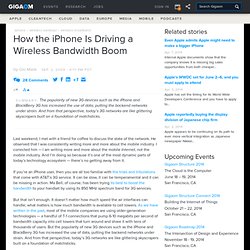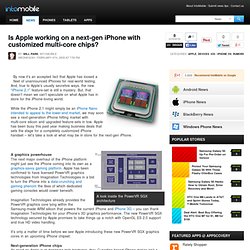

How the iPhone Is Driving a Wireless Bandwidth Boom. Last weekend, I met with a friend for coffee to discuss the state of the network.

He observed that I was consistently writing more and more about the mobile industry. I corrected him — I am writing more and more about the mobile Internet, not the mobile industry. And I’m doing so because it’s one of the most dynamic parts of today’s technology ecosystem — there’s no getting away from it. If you’re an iPhone user, then you are all too familiar with the trials and tribulations that come with AT&T’s 3G service. It can be slow, it can be temperamental and it can be missing in action. But that isn’t enough. The current buildout of wireless networks is mirroring that of the wired Internet in the late 1990s and early part of this decade. So every time you look up Facebook on your handset, you’re contributing to the strain on those wireless networks. This is clearly a big opportunity not only for new startups, but also for more established equipment makers. Related Posts: Android and iPhone Dominated Mobile Browsing in April. Google’s Android and Apple’s iPhone together accounted for almost three-quarters of web browsing on mobile devices in April, yet not even 10 percent of device sales, according to the most recent Mobile Metrics Report from AdMob.

But they were the only two — Symbian-, RIM- and Windows Mobile- based devices all outsold Apple and Google; their users’ web browsing, meanwhile, came in significantly lower. The browsing usage data of the iPhone and G1 (the U.S. name of the only Android-based phone at the moment) makes sense, given how the rest of the industry is still largely playing catch-up to the strong Internet experiences these two devices provide. That gulf should narrow, however, as the web browsing capabilities of more and more devices get beefed up. Is Apple working on a next-gen iPhone with customized multi-core.
By now it’s an accepted fact that Apple has loosed a fleet of unannounced iPhones for real-world testing.

And, true to Apple’s usually secretive ways, the new “iPhone 2,1” feature-set is still a mystery. But, that doesn’t mean we can’t speculate on what Apple has in store for the iPhone-loving world. While the iPhone 2,1 might simply be an iPhone Nano intended to appeal to the lower-end market, we may soon see a next-generation iPhone hitting market with multi-core silicon and upgraded feature-sets in tow.
Apple has been busy this past year making business deals that sets the stage for a completely customized iPhone handset – let’s take a look at what may be in store for the next-gen iPhone. A look inside the PowerVR SGX architecture A graphics powerhouse The next major overhaul of the iPhone platform might just see the iPhone coming into its own as a graphics-savvy gaming platform. And, therein lies the next piece of our next-generation iPhone puzzle. IBM Cell. Juniper Research: Promotional coupons sent via mobile phones to.
According to a new Juniper Research’s study, coupons delivered and redeemed via mobile phones are forecast to be used by some 200 million mobile subscribers globally by 2013.

At the moment, mobile coupons market is most advanced in Japan and Korea, but USA and Europe are slowly catching up and mobile coupons have started appearing at all the main retail sectors including restaurants, entertainment, shopping and grocery. The developed nations of the Far East, North America and Western Europe are forecast to account for the major part of the market by 2013.
Report author Howard Wilcox argues that even though today the overwhelming majority of coupons are paper-based, the mobile phone is the ultimate individual marketing device and mobile coupon pilots have shown greatly increased redemption rates – often double digit percentages. More information about Juniper Research’s study “Mobile Coupons: Strategies & Forecasts 2008-2013″ is available from their website. Apple diminui produção do iPhone - INFO Online - (03/11/2008) Mercado desmartphones ainda tem muita a crescer na América Latin.